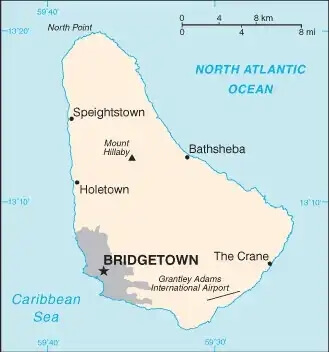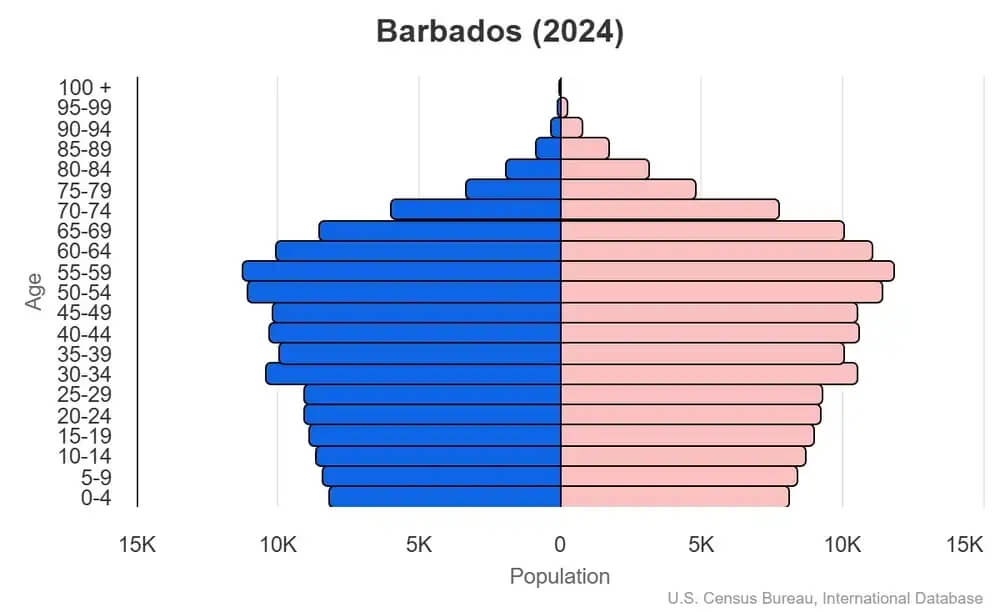World Book
Barbados
Introduction
Background
Barbados was uninhabited when first settled by the British in 1627. By 1720, the island was no longer a dominant force within the sugar industry, having been surpassed by the Leeward Islands and Jamaica. Social and political reforms in the 1940s and 1950s led to independence from the UK in 1966. In 2021, Barbados became a republic.
Geography
Area
total : 430 sq km
land: 430 sq km
water: 0 sq km
Climate
tropical; rainy season (June to October)
Natural resources
petroleum, fish, natural gas
People and Society
Population
total: 304,139 (2024 est.)
Ethnic groups
African descent 92.4%, mixed 3.1%, White 2.7%, East Indian 1.3%, other 0.2%, unspecified 0.3% (2010 est.)
Languages
English (official), Bajan (English-based creole language, widely spoken in informal settings)
Religions
Protestant 66.4% (includes Anglican 23.9%, other Pentecostal 19.5%, Adventist 5.9%, Methodist 4.2%, Wesleyan 3.4%, Nazarene 3.2%, Church of God 2.4%, Baptist 1.8%, Moravian 1.2%, other Protestant 0.9%), Roman Catholic 3.8%, other Christian 5.4% (includes Jehovah's Witness 2.0%, other 3.4%), Rastafarian 1%, other 1.5%, none 20.6%, unspecified 1.2% (2010 est.)
Population growth rate
0.23% (2024 est.)
Government
Government type
parliamentary republic; a Commonwealth realm
Capital
name: Bridgetown
Executive branch
chief of state: President Sandra MASON (since 30 November 2021)
head of government: Prime Minister Mia MOTTLEY (since 25 May 2018)
Diplomatic representation in the US
chief of mission: Ambassador Victor Anthony FERNANDES (since 18 September 2024)
Diplomatic representation from the US
chief of mission: Ambassador (vacant); Chargé d'Affaires Karin B. SULLIVAN (since January 2025); note - also accredited to Antigua and Barbuda, Dominica, Grenada, Saint Kitts and Nevis, Saint Lucia, and Saint Vincent and the Grenadines
Economy
Economic overview
high-income Eastern Caribbean economy; high standard of living among regional peers; key tourism, construction, and financial sectors driving recent GDP growth; declining but still very high public debt leading to IMF support programs; susceptible to natural disasters and reliance on import partners
Real GDP (purchasing power parity)
$5.634 billion (2024 est.)
$5.428 billion (2023 est.)
$5.214 billion (2022 est.)
Real GDP per capita
$19,900 (2024 est.)
$19,200 (2023 est.)
$18,500 (2022 est.)
Exports
$2.228 billion (2017 est.)
$2.41 billion (2016 est.)
$2.358 billion (2015 est.)
Exports - partners
USA 22%, Jamaica 17%, Trinidad & Tobago 8%, Canada 6%, Guyana 6% (2023)
Exports - commodities
liquor, refined petroleum, packaged medicine, margarine, baked goods (2023)
Imports
$2.12 billion (2021 est.)
$2.213 billion (2017 est.)
$2.238 billion (2016 est.)
Imports - partners
USA 32%, Trinidad & Tobago 19%, Netherlands 6%, UK 6%, Guyana 5% (2023)
Imports - commodities
refined petroleum, crude petroleum, cars, plastic products, ships (2023)
Human Development Index
The country's Human Development Index (HDI) is 0.811, ranking it 69th out of 193 countries tested. (more information)



